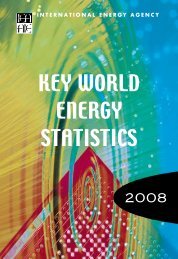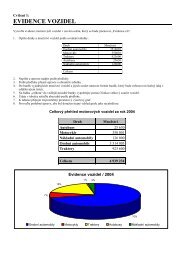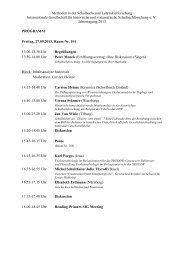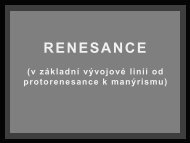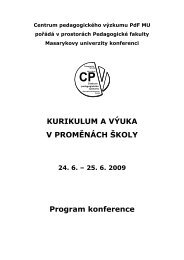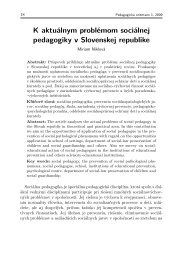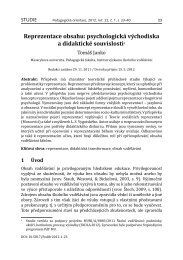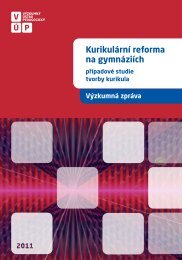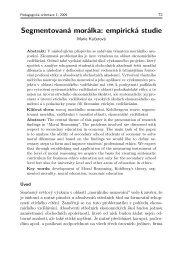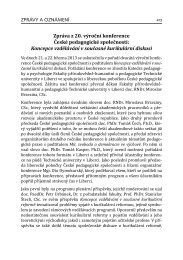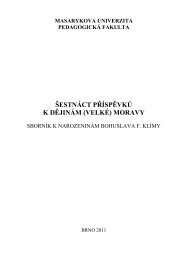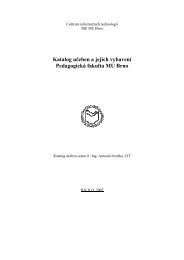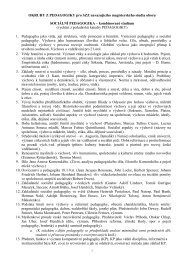Bytheway - Pedagogická fakulta MU - Masarykova univerzita
Bytheway - Pedagogická fakulta MU - Masarykova univerzita
Bytheway - Pedagogická fakulta MU - Masarykova univerzita
You also want an ePaper? Increase the reach of your titles
YUMPU automatically turns print PDFs into web optimized ePapers that Google loves.
Y KENNETH G. HAY<br />
KENNETH G. HAY<br />
CREATIVITY, BY THE WAY...<br />
There are many prevalent myths about artistic creativity.<br />
Perhaps the most prevalent is the image of the isolated artistic<br />
genius, suffering for their art, misunderstood and undervalued<br />
by the society from which s/he springs, but more often than<br />
not, to which they are linked only tenuously. This mythical image<br />
fi rst appears in the Renaissance, if we are to believe Giorgio<br />
Vasari, with eccentric and troubled artistic personalities like<br />
Piero di Cosimo, hiding away from society, living off hard boiled<br />
eggs which were brought to him daily, because he was afraid<br />
of lighting a fi re; or Jacopo Pontormo, so paranoid about dust<br />
interfering with the glassy smoothness of his paintings that he<br />
would sit quite still until it had all settled before applying fresh<br />
varnish to his painting. Such images proliferate in Mannerism,<br />
where maniera, or refi ned style, celebrated and encouraged<br />
eccentricity, and continue through Romanticism, to the Modern<br />
period, where they reach their tragic apogee in Van Gogh.<br />
They are diffi cult images to shake off, and myths have a habit<br />
of lingering. But myths, as Roland Barthes observed, are useful<br />
ways of disguising half-truths, or even total fi ctions, as fact;<br />
and most myths are ideological – they present a partial view<br />
as a complete view.<br />
Contrary to the Romantic view of the isolated artist is another<br />
image, more accurate, because more complete. The artist as<br />
social animal, gregarious, surrounded by colleagues, models,<br />
critics, gallerists; discussing ideas with fellow artists, sitting<br />
in cafés, arguing over the newspapers, inventing Cubism,<br />
writing Manifestos, forming groups and movements. Very little<br />
art, in fact, has sprung, unbidden and spontaneous, from an<br />
isolated artist’s head. Most art comes from other art. Most of<br />
the inspiration to write a sonnet comes from reading and falling<br />
in love with the sonnet form as perfected by others. We learn<br />
what oil painting can do, and want to test its limits for ourselves,<br />
because we have see other paintings. The Italian philosopher<br />
Antonio Labriola called this cultural continuity an endless chain<br />
stretching back into the past and linking us and our ambitions<br />
with the aspirations of our antecedents, stretching out beyond<br />
their time. We pick up the echoes and the rumours of what has<br />
gone before, attune ourselves to hear it well, and then continue<br />
its song.<br />
Creativity, seen in this light is less mysteriously the creatio<br />
ex nihilo – the totally mystical and unprecedented introduction<br />
k.g.hay@leeds.ac.uk<br />
Kenneth G. Hay is Professor of Contemporary Art Practice, Head of the Department of Contemporary Art Practice<br />
within the School of Design and Deputy Head of the School of Design at the University of Leeds, UK. His digital,<br />
sound and other artworks have been exhibited most recently in Korea (Busan Biennale), Malta(2008), Tainan<br />
(2006), Venice Biennale (1996,2003), and the Czech Centre for Experimental Theatre (2003). His publications<br />
focus on issues of inter-semiotic translatability, modernist and postmodernist art theory, aesthetics and Italian art<br />
and culture.<br />
of something absolutely new into the world – as a process of<br />
absorption, transformation and recombination, albeit in a new<br />
way, of elements pre-existing in the work of others. It is a social<br />
process, which grows out of a specifi c context in time and<br />
space. It explores certain formal or ideological parameters<br />
already patent or latent in the work of precursors, within the<br />
context of a given social, geographic, temporal, historical,<br />
gendered etc. perspective, and comes up with a new amalgam.<br />
The impetus to this process is given by equally specifi c causes:<br />
market pressures, philosophical/legal/scientifi c/religious (in<br />
short superstructural) climate; geo-political zeitgeist etc., as<br />
much as it is driven by the power of individual artistic sensibility.<br />
This is not to undermine or underestimate the necessity and<br />
power of individual artistic sensibility. It is just to recognise the<br />
fact, rather than the myth, of artistic creation: that it occurs in<br />
and from a group, at a particular time and place, in a particular<br />
context, accompanied by discussion, critical analysis and<br />
input from others, for a given audience, in a particular social<br />
situation.<br />
One such context is the Ph.D programme at Masaryk<br />
University, Brno. Another is that existing in the School of Design<br />
at the University of Leeds. Yet another is the Cyprus School<br />
of Art, Lempa. All three locations are more than geographical<br />
signifi ers – the three contexts are linked in a complex web of<br />
overlapping personalities and histories: student exchanges,<br />
staff collaborations, research projects, exhibitions, discussion,<br />
cooking, friendships, publications and hospitality. The current<br />
project of staff and students from these institutes affords the<br />
opportunity to explore such notions of creativity together,<br />
to travel and discuss ideas, to exchange staff and students,<br />
histories and contexts, in an on-going and open series of<br />
collaborations, and via the web-site and publication, to extend<br />
the links of this endless chain outwards to the world.<br />
Here, I wish only to examine and critique, two contrasting<br />
views of the creative process, centring upon the most extreme<br />
example of artistic creativity: the notion of originality and artistic<br />
genius, within the context of Ph.D study:<br />
In science, a new contribution to human understanding can<br />
be pointed out with some clarity – a new equation, or a more<br />
elegant reformulation of an existing formula – can lead to<br />
quantifi able and demonstrably new knowledge. How then, do<br />
artworks operate? If we accept that artworks are intellectual<br />
and thereby ipso facto contribute to thought, how are we to<br />
judge them? And indeed, is judgment a relevant issue here?<br />
TEXTY_01_VESMIRY_finale.indd 5 30.3.2009 23:05:39<br />
5 P



